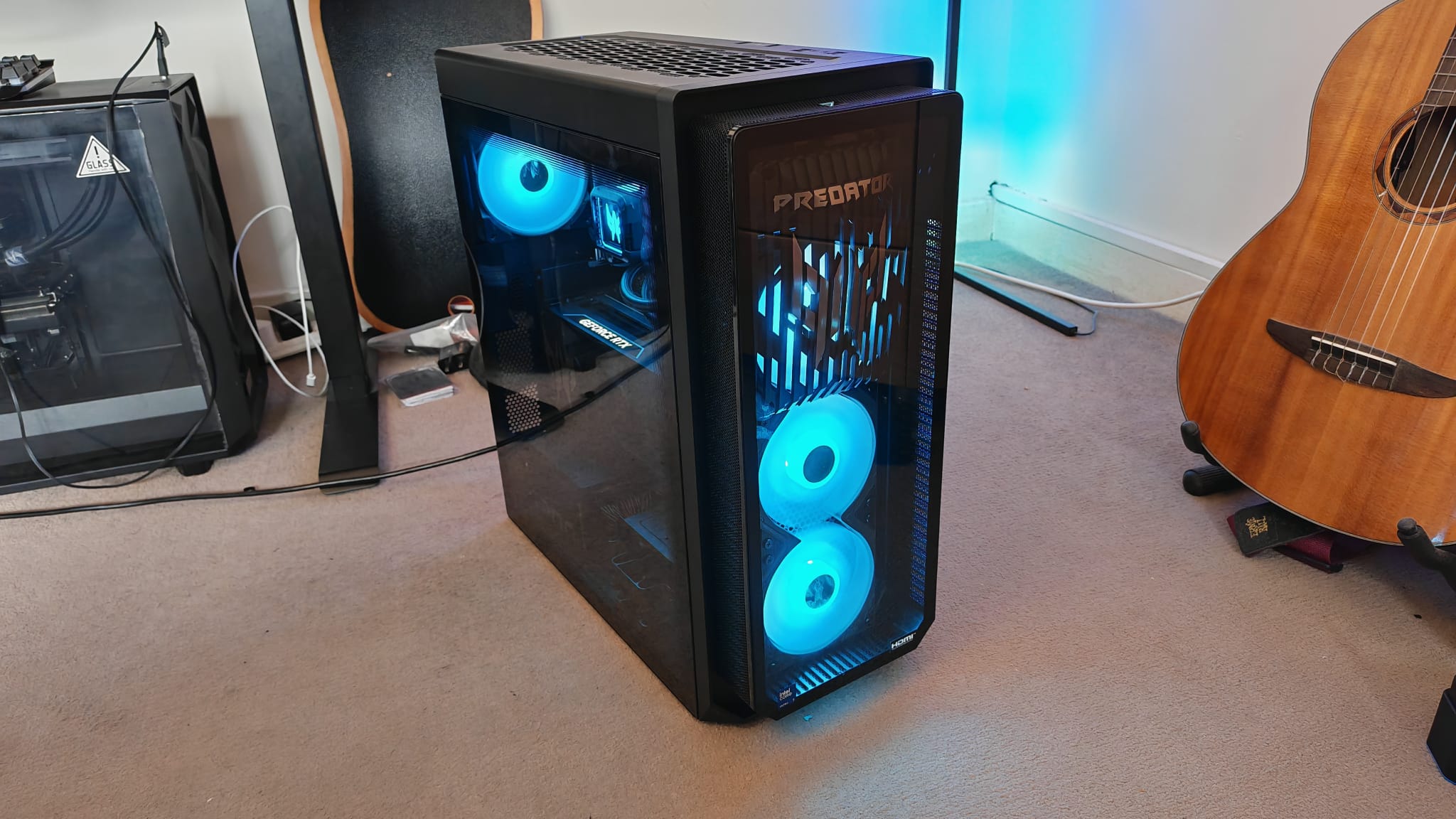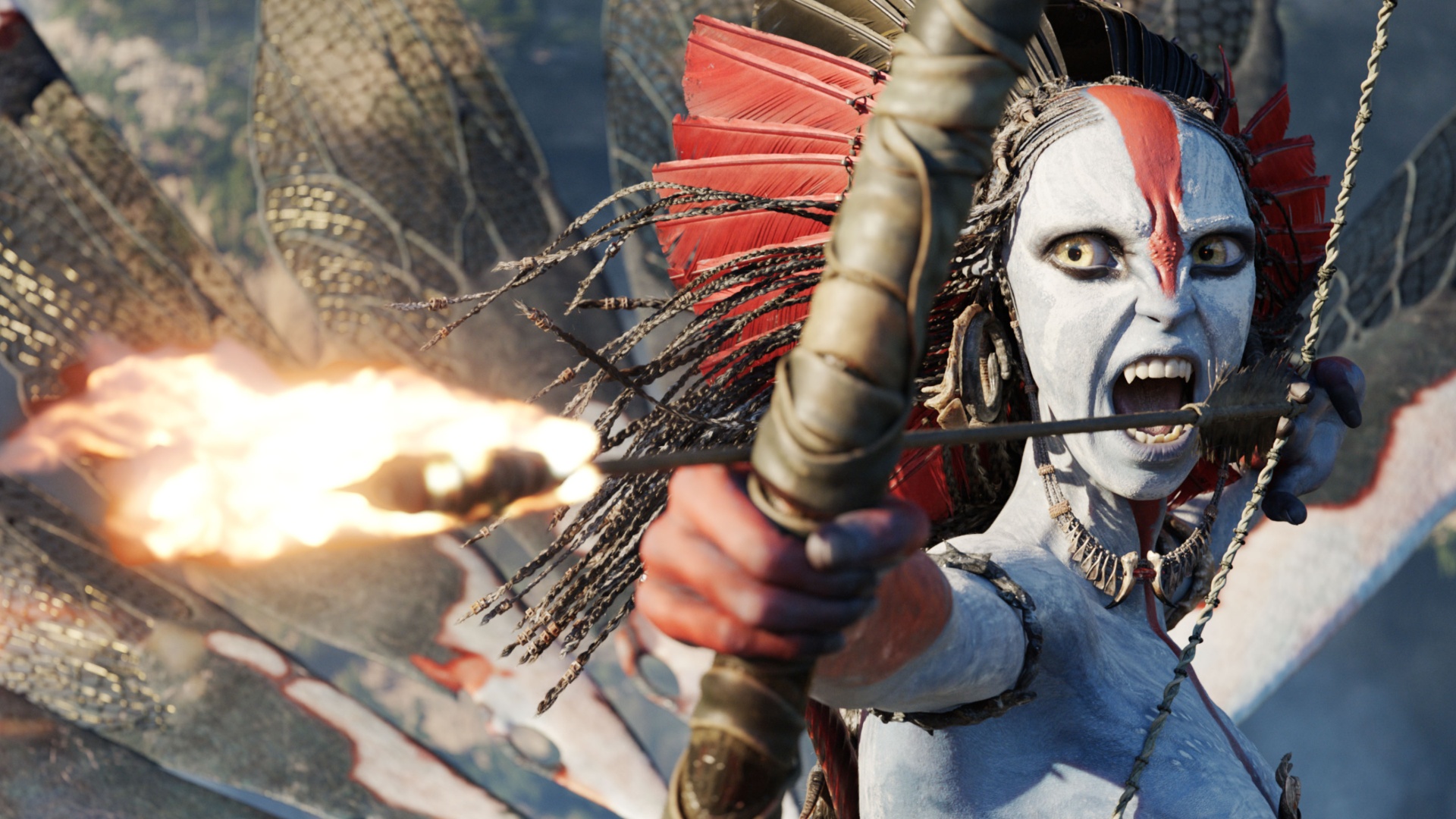GamesRadar+ Verdict
Massive improvements to cooling are the best thing about the latest version of the Acer Predator Orion 7000. While playing demanding games on it, I can now hear myself think, which wasn't the case with 2023's model. Now harnessing even newer, more powerful parts, this is every bit the gaming powerhouse that I've come to expect from this line of PCs. That said, this feels like it's missing the best thing about Acer's PC offerings in recent years: one of its homemade AMD GPUs. I'd love to have seen some AMD Orion configurations, because it might have helped to bring their infamously high prices down to a more reasonable level.
Pros
- +
Massive improvements to cooling
- +
Much, much quieter fans
- +
Up to an RTX 5090 GPU
- +
Great RAM
- +
Excellent SSD
Cons
- -
Very pricey
- -
SSD heatsink was missing
- -
LGA1851 motherboard likely won't have as much futureproofing as AM5
- -
No AMD GPU options
- -
Very stingy connectivity
Why you can trust GamesRadar+
I didn't have the best time with the last iteration of the Acer Predator Orion 7000. When it arrived, one of the RAM sticks wasn't seated properly, there may have been a problem with the AIO cooler, and the sheer volume of the case fans made it a tough rig to like. Regardless, it was hard to argue with the Intel Core i9-13900K processor and RTX 4090 GPU inside it. So, despite some pitfalls, it was still up there with the best gaming PCs you could find.
Since then, Acer has been hard at work in the PC market. The next rig from this brand was the excellent Acer Predator Orion X, a small form factor monster that cured so many of the 7000's ills. In the last two years, we've also seen an emergence of graphics cards, SSDs, and RAM, all made by Acer and sold out with their prebuilt PCs. Then, at IFA last year, we got the news that Acer was listening to feedback, and with the next iteration of its Predator Orion PCs, much quieter, more efficient cooling would be a key focus.
This really cemented in my head that Acer doesn't just want to make PCs and components, it wants to make PCs and components of the highest order, and a willingness to listen to feedback is a telltale sign of a brand that wants to improve. The only problem? Quality comes at the highest end of the price scale. This configuration of the new Predator Orion 7000 that I'm testing will set you back £3,299 in the UK, with a US price still to be confirmed. Expensive RTX 5080 GPU or not, that's a high price to pay for a PC - even one as powerful as this.
Specs
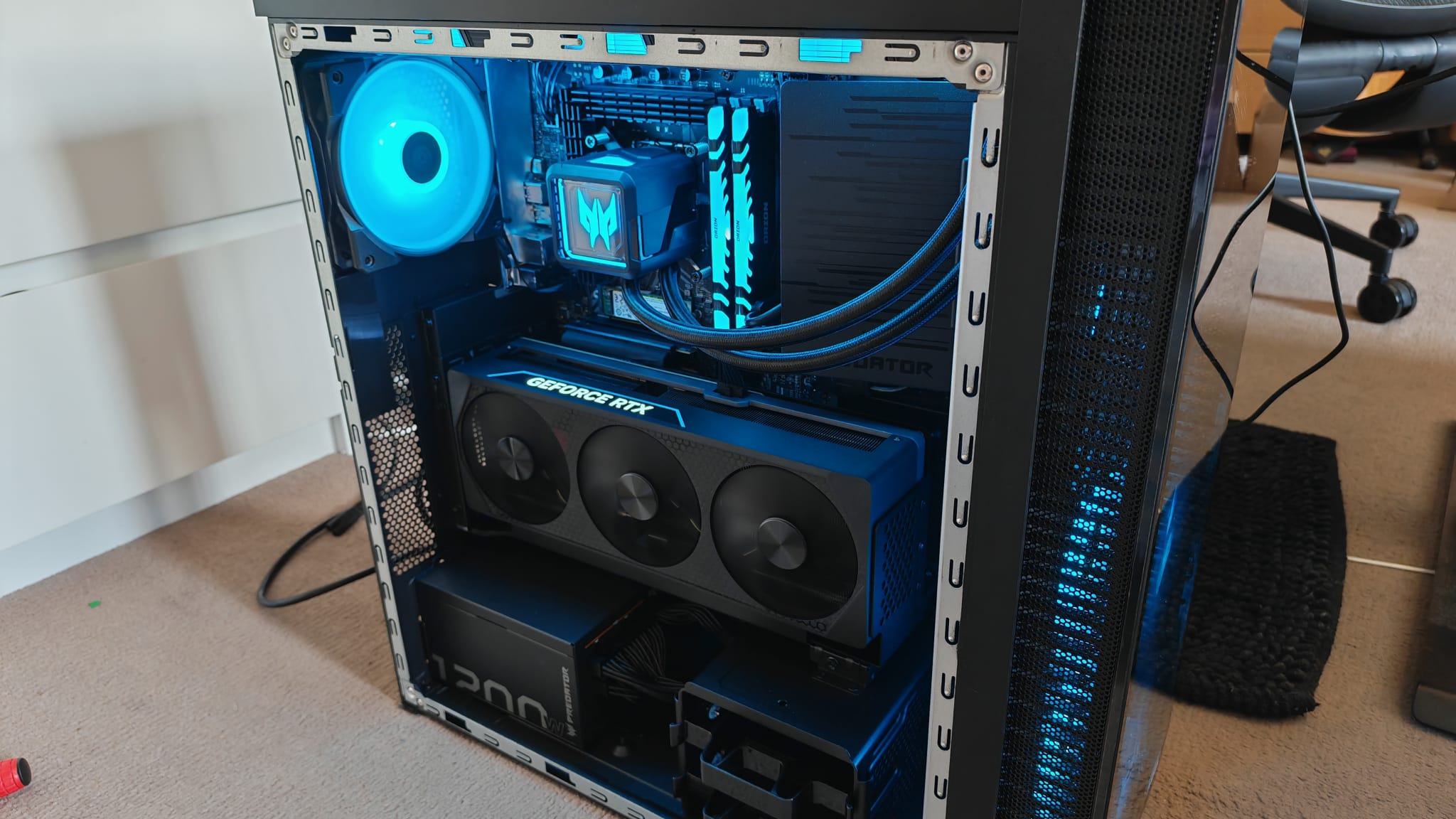
I do have to wonder if an AMD configuration was ever on the cards for Acer's latest range of gaming PCs. The new chassis was revealed back in September 2024, and although Intel and Nvidia have always supplied the Orion machines with CPUs and GPUs, it feels like there's been a rather large change of momentum for both of those brands since that reveal. Nvidia's 50 Series GPUs haven't had the best reception, Intel's Arrow Lake desktop processors have been fighting an uphill battle to improve performance since launch, and a lack of support for legacy motherboards has played right into AMD's hands.
In fact, one con of this build is that by opting for the Intel Core Ultra series processors, the LGA1851 CPU socket may not be as future-proofed as an AM5 motherboard would have been. Essentially, Intel is a lot less likely to service this particular motherboard with new CPUs for you to upgrade to than AMD is.
For a brand that's beginning to produce all of its own components now (including AMD Radeon GPUs, not Nvidia ones), I'd be very interested in seeing what a fully homegrown Acer Predator Orion 7000 could look like. As it stands, these Predator Orion motherboards are locked to Intel CPUs, and I wouldn't be surprised if there were contracts in place for Nvidia to brandish them with its GPUs.
Price | £3,299 (US price pending) |
CPU | Intel Core Ultra 7 256KF |
GPU | Nvidia GeForce RTX 5080 |
RAM | 32GB of Acer Orion DDR5 RAM |
Storage | 2TB "SK Hynix HFS002TEJ9X125N" SSD |
Cooling | Acer Predator BiFrost AIO cooler and Predator CycloneX 360 fan system |
Motherboard | Acer Predator PO7-660 Motherboard |
Case | Acer Preadator Orion 7000 2025 |
There definitely seem to have been at least some changes made in the time between reveal and launch, because when I saw the Predator on the IFA show floor last year, it was holstering an RTX 4090. The engineers on the Acer team did hint to me that there would be availability for the 50 Series GPUs (which were only rumoured to be in the works back then). Almost a year later, it looks like those 50 Series cards are the only options for this rig now. Perhaps delays in the Predator Orion 7000 actually hitting the shelves have come from graphics card stock shortages rather than a proposed change of GPU supplier. Either way, you can get up to an RTX 5090 in the new Orion 7000.
Weekly digests, tales from the communities you love, and more
As for the other specs, Acer says you can get up to 128GB of DDR5 RAM, although 32GB seems to be the standard you'll get out of the box. You can have up to 6TB of PCIe M.2 storage out of the box, but some SATA trays and a handy M.2 hot-swappable SSD enclosure in the roof of the chassis allow you to add more of your own. The processor I have in this rig is an Intel Core Ultra 7 265KF, but you can get yours with up to Intel's Core Ultra 9-265.
Thankfully, if an RTX 5080 or 5090 configuration is too rich for your blood, the Acer Predator Orion 5000 variants often come out a little later, offering a cheaper sum of parts for less power. As a drawback, you may only get two front fans as opposed to the three found in the 7000 Series machines, but that may not be too big an issue if you get the same AIO cooler.
Design

Speaking of cooling, that's where the biggest differences lie between this version of Acer's flagship desktop and the older models. Hands down, the worst thing about the previous version was its noise levels and inadequate cooling. To be absolutely fair, the Acer Predator Orion 7000 (2023) had its work cut out for it trying to keep a 13th Generation Intel flagship CPU cool, but my god, I don't know what was happening with the AIO and thermals in the version I tested. The CPU was regularly reaching the boiling point in stress tests, and when I say the PC was loud, it may still hold the record for the noisiest prebuilt PC I've ever tried.
Comparing it to the 2025 model is night and day, however, and that's all down to innovations that Acer has made. I have to give the brand credit where it's due; these aren't exactly small reworks - a redesigned fan system and AIO cooler that has a higher RPM feel like "from the ground-up" level updates. And it shows, because this PC has been so stealthily quiet from the moment I started testing it.
The innovations come from the removal of the interior walls between the three system fans. By taking these out, Acer found that it could reduce motherboard temperatures by a quoted 9°C in its in-house tests. The AIO's pump header now operates at 3,400RPM, and a redesigned "cool plate" apparently boosts heat absorption. After looking inside the PC and seeing the enormity of the pump header, I'm not surprised in the slightest by those 9° testing differentials - that thing is massive!
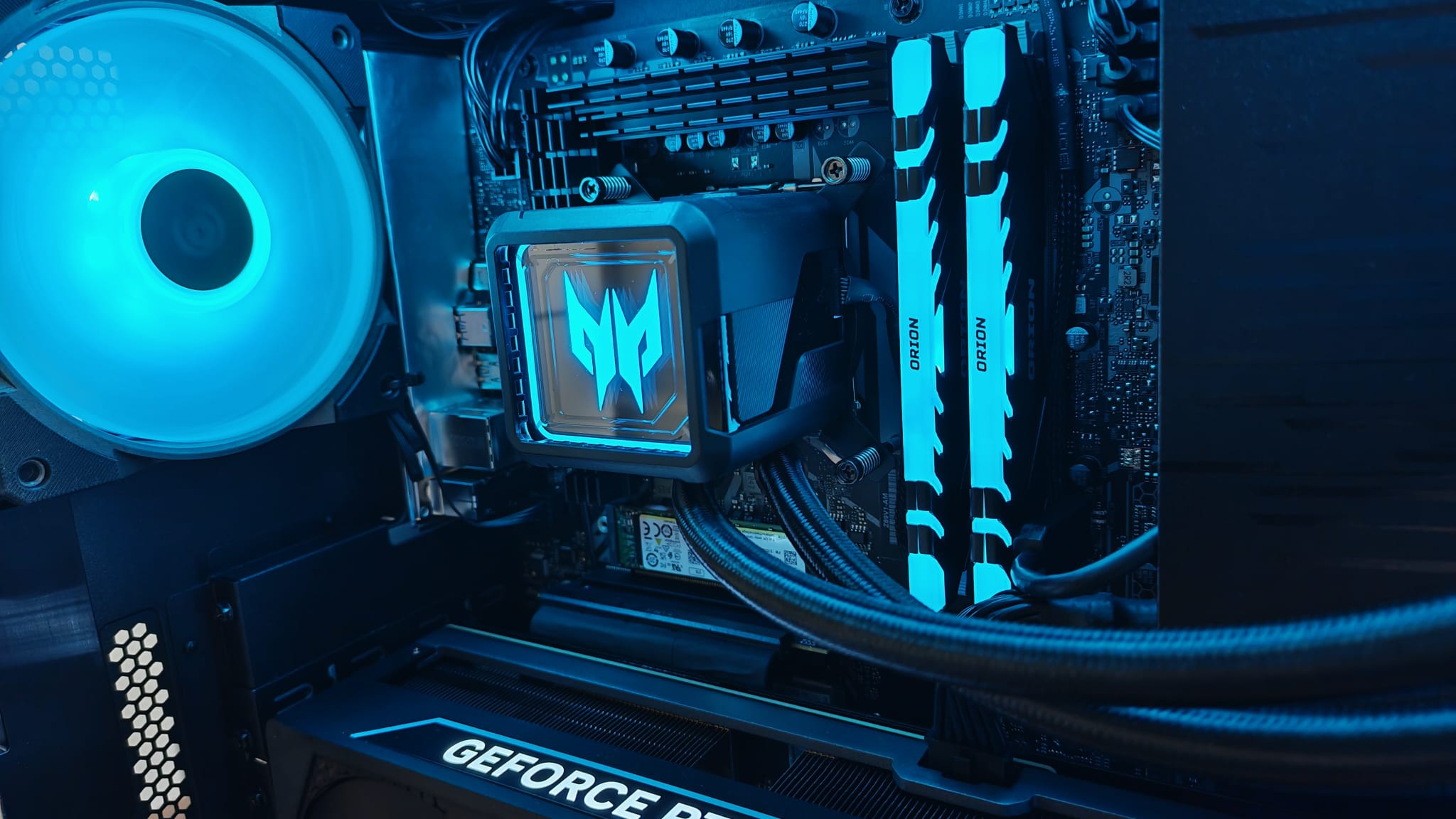
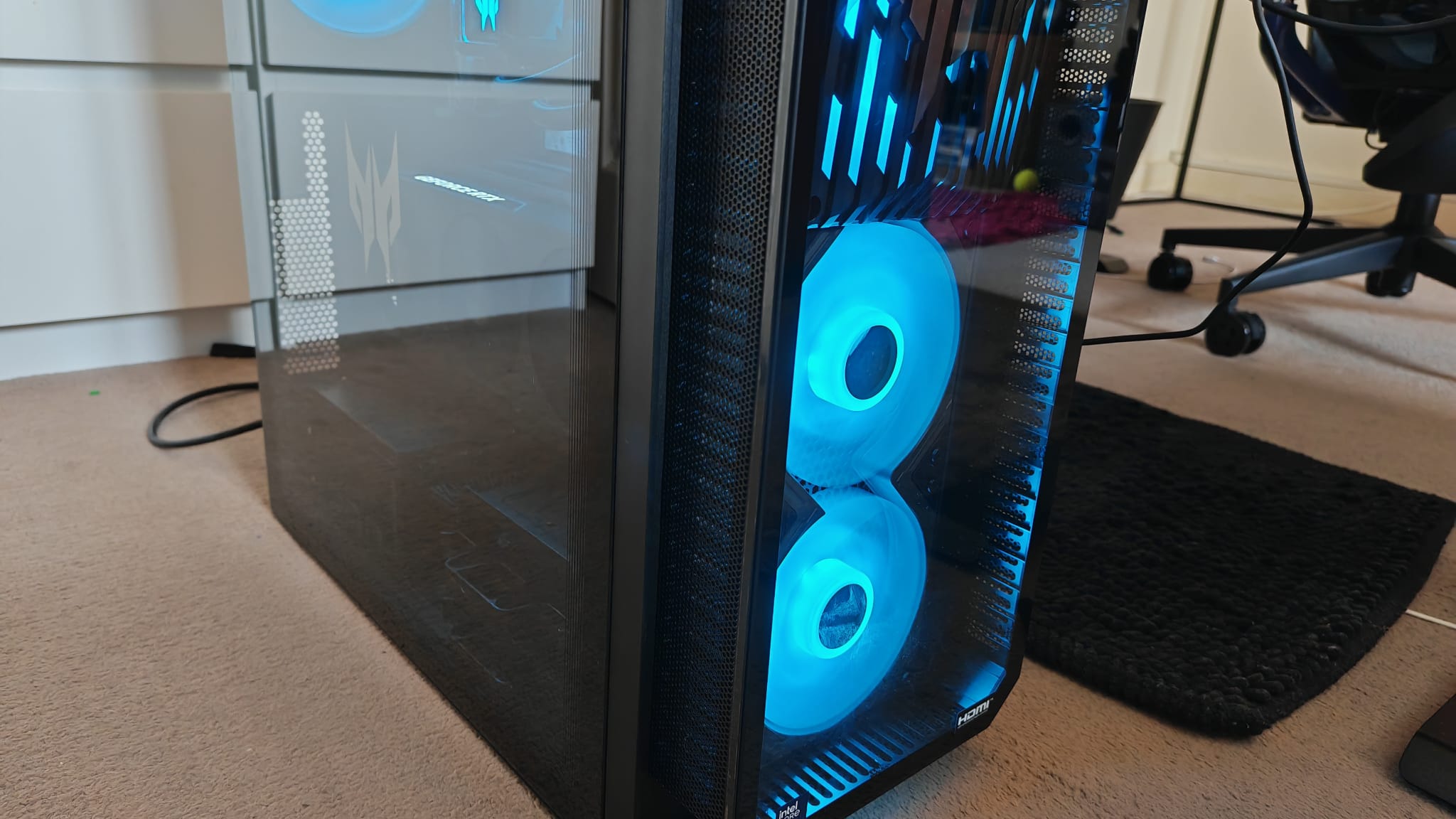
When I first got up close and personal with the new Orion 7000 chassis, I was a little worried that all this cooling innovation would be hamstrung by the fact that the front panel only has a small, side mesh wall on its borders. I was wrong because there was no point during the testing process for this rig where I noticed the fans kicking up.
Covering the top intake fan on the front of the case is a bold Predator symbol, which also appears on the tempered glass panel and on the AIO's pump head. RGB lighting from the fans and Acer RAM purrs beautifully from within, creating a really nice afterglow effect.
Acer's homemade PSU caters up to 1200W, which is more than enough for what's in this high-end configuration I'm reviewing, but also gives you plenty of room to upgrade later if you opt for a more reasonable 5000 system.
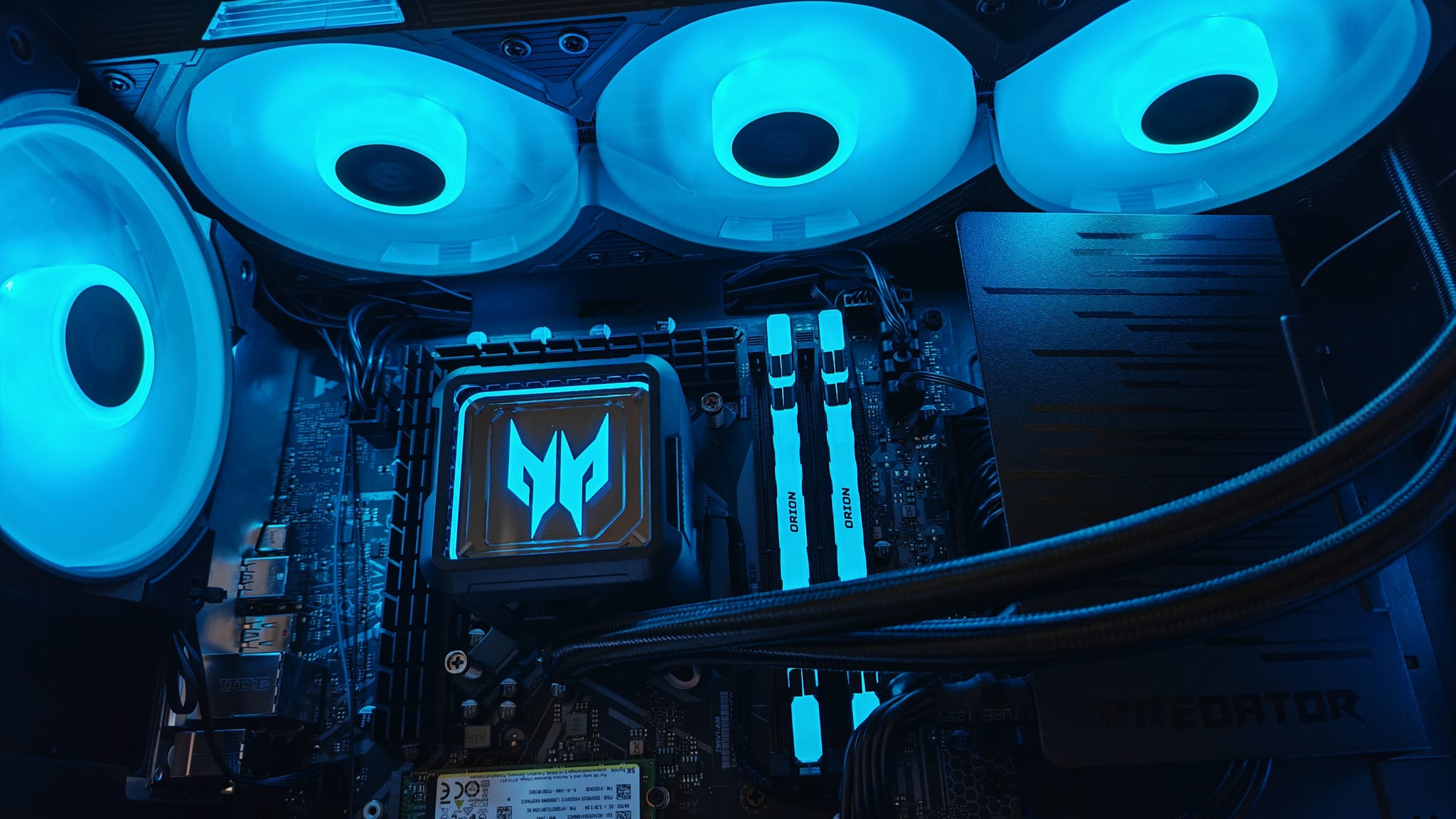
Acer's own motherboard does have a few drawbacks, though. The BIOS still feels really limited, even if it does simplify more complex menu systems for newcomers to PC gaming. The worst part is that its rear IO feels like it's been halved. You get 1x USB-C port, 3x USB 3.2 ports, and 2x USB 2.0 bays. You also get an Ethernet port and some audio jacks, but that's it. No Wi-Fi antenna slot, the motherboard is fitted with Wi-Fi 7. But compare that to the NZXT Player Three RTX 5080 Edition, which has ten USB ports on its rear IO alone, and Acer's motherboard seems oddly stingy. On top of the new Predator Orion chassis, you get an additional 1x USB-C, and 3x USB 3.0 ports, but those aren't exactly practical if you have lots of things to plug in. As someone with all sorts of content creation gadgets like Stream Controllers and Audio mixers in use at any one time, that didn't feel like enough for me.
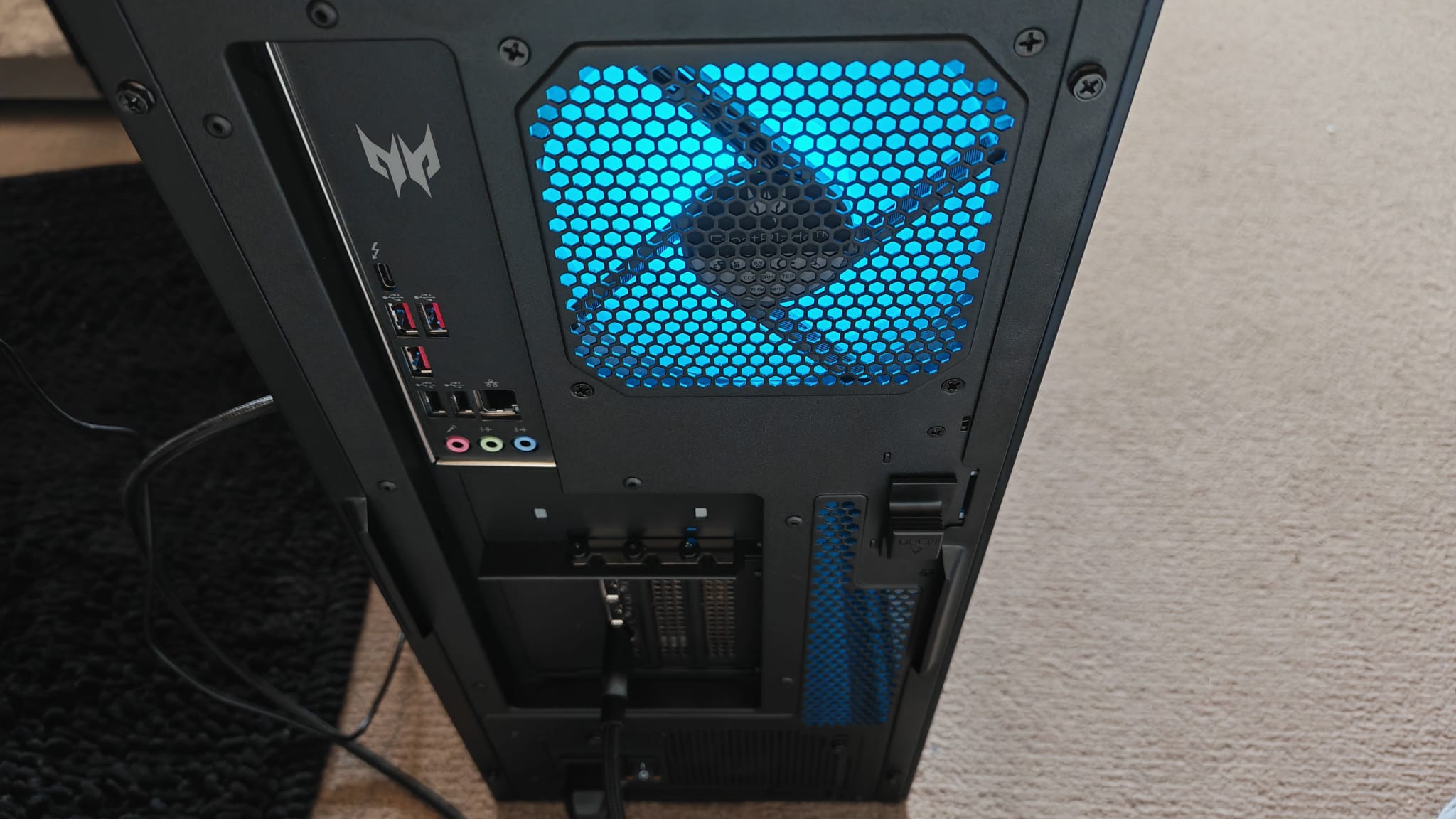
In terms of display, you get 1x HDMI 2.1 port in your GPU, alongside 3x DisplayPort 2.1 slots. Like last time, the GPU has been mounted in the inverted position, which certainly looks nice and stops any degree of sag occurring, but it does make getting in and around your motherboard a lot tougher. In fact, with all the quirky branding and panels inside the PC that hide the motherboard and cable clutter, this really comes across as a PC that's not designed to be upgraded or modified in any way. That's reflected by the case's transparent panel, which you still need to unscrew with a screwdriver to remove - in 2025, no less.
Performance
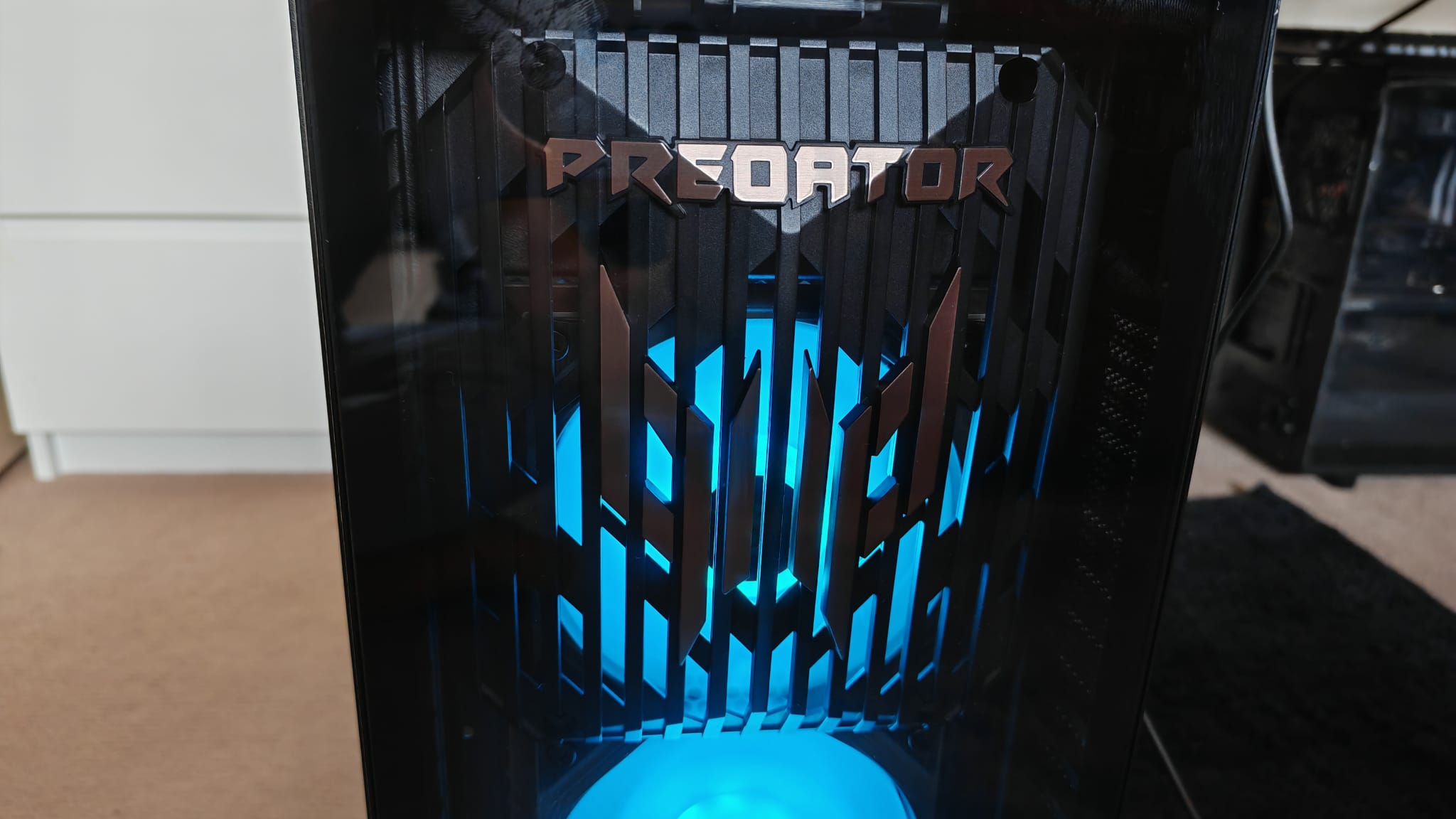
The first thing I want to make clear, and get out of the way, is that while testing this rig, I had no issues of overheating and barely noticed the fans working. This is what you should expect from a PC that you need to spend upwards of £3,000 on, but it's such a stark contrast from the last iteration of this machine. It's a huge win for Acer, and it shows what can happen when feedback is taken on board. It's not all that common that bigger names in this market do something like that, and often big companies in the PC space can act in ways that are anti-consumer. We see that all too often, but Acer is bucking the trend.
On the other hand, high prices aren't exactly pro-consumer, but I'll talk more about that later on. For now, let's focus on performance.
While doing stress tests and demanding benchmarking, I didn't see the CPU reach a temperature above 85°C, and the GPU above 71 °C. That's a massive improvement from the CPU frequently reaching boiling point last time around. Granted, the AIO has a much easier job here since its processor isn't the hot-headed Intel Core i9-13900K. Still, the redesigns are doing their job, and the PC stays sublimely quiet, even under stressful loads.
Cinebench:
Multi Core: 28432pts
Single Core: 2191pts
3DMark:
TimeSpy: 27 915
Firestrike: 45 728
Steel Nomad: 85.73
CrystalDiskMark:
Sequential read: 7,043MB/s
Sequential write: 6403MB/s
AIDA64 Extreme / RAM readings:
92,076 MB/s read, 101.6ns latency
40-40-40-76
(6,000MT/s)
For me, the most natural point of comparison for the new Predator Orion 7000 is another RTX 5080 build I tested this year, the NZXT Player Three. Similarly, the CyberPowerPC Ultra XT3D, which sports a slightly weaker AMD Radeon RX 9070 XT GPU. Both of those machines harness an AMD Ryzen 7 9800X3D processor, so comparing their benchmarking scores with Acer's latest Intel powerhouse is very interesting.
The Orion scores the highest of the three in Cinebench's multicore CPU test, as the other two both came in just shy of 23,000 points. In the single core tests, the two comparison PCs came in with ~2090pts, while the Orion 7000 scored just above that with 2191pts. It might seem like Intel's CPU is outperforming AMD, but when we switch to more gaming-oriented benchmarks, things aren't so clear-cut. In 3DMark's FireStrike test, the NZXT rig came out with the highest score of 55,985, which, for some reason, Acer's build was 10,000 short in. Besides that, the Orion 7000 came out on top in every benchmarking score.

One area where Acer is really showing its strength is in memory and storage. Both the NZXT Player Three and the CyberPowerPC custom build fall victim to one of the most common shortcomings of any prebuilt gaming PC: a weak SSD. Both of them scored sequential read speeds in CrystalDiskMark of under 5,000MB/s, which is dreadful for the types of power those machines have (not to mention the amount they cost). A weaker SSD is common in prebuilt gaming PCs because it's a component that will keep costs down while also catching the least flak when you're talking about a few seconds extra of loading time. But as someone who also reviews SSDs individually, that doesn't sit well with me.
It's a gaming powerhouse, and the innovations and improvements that have gone on behind the scenes have made massive strides to tackle the issues I had with its predecessor. On the other hand, I can't ignore that this PC is extremely pricey.
Acer's 2025 edition of the Predator Orion embarrasses the other gaming PCs we've tested lately by using SSDs that are at the upper echelon of the Gen 4 market, and that's how it should be. Storage is a real, real strength of this build, and if you care about the shortest of loading and file transfer times, this is a PC well worth considering. It is a bit odd to me that Acer didn't throw one of its own SSDs in here, though. I was a bit confused when I first looked inside the chassis and saw an SK Hynix drive that didn't even have its motherboard heatsink on. There's a screw next to the M.2 port, which indicates that there is a motherboard heatsink panel, but it isn't anywhere to be found in my testing build. Thankfully, the SSD only peaked at 50 degrees in my benchmarking, so the thermal sticker is clearly doing its job. Still, this is a small building quirk that I'm a little confused by.
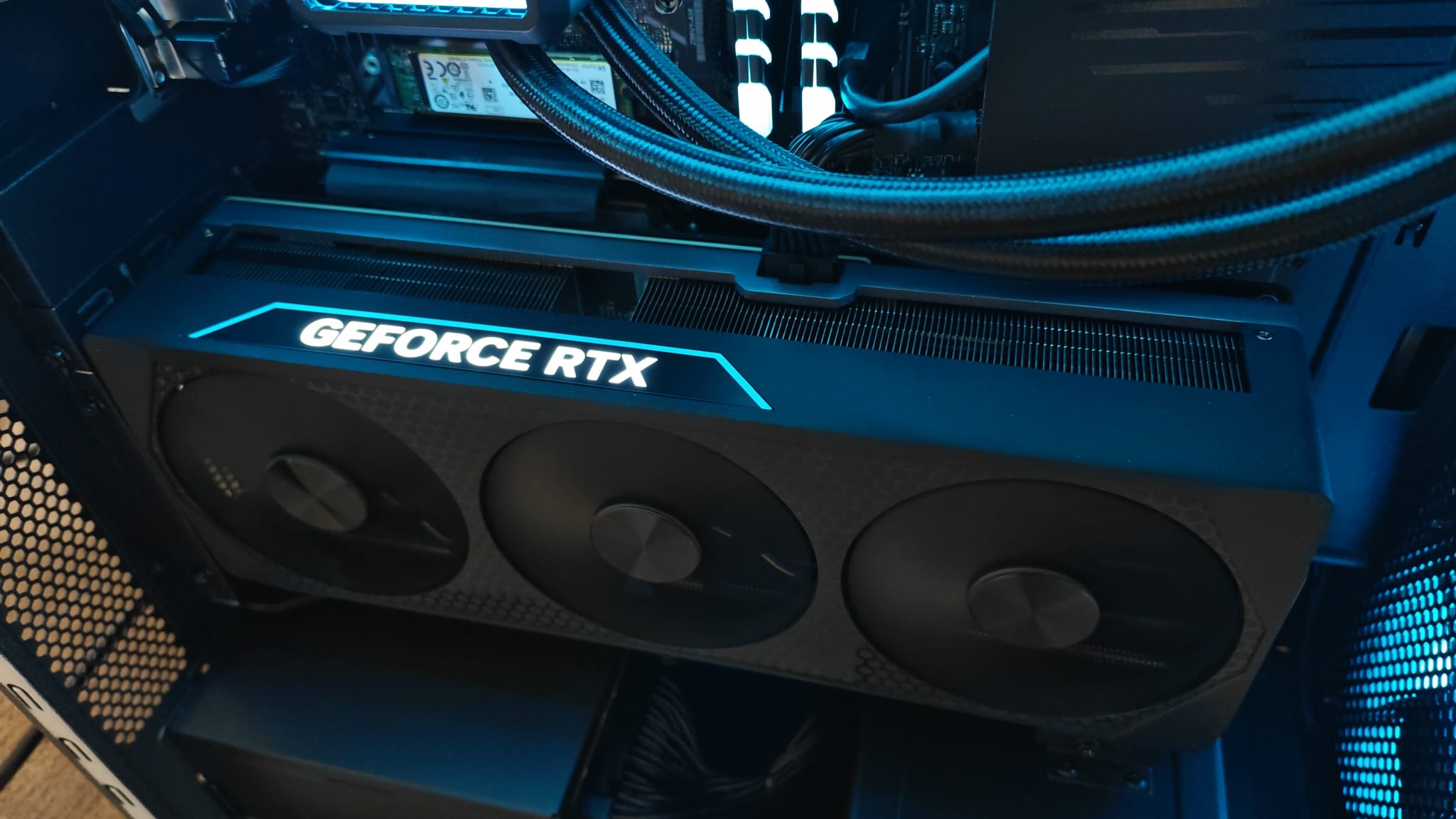
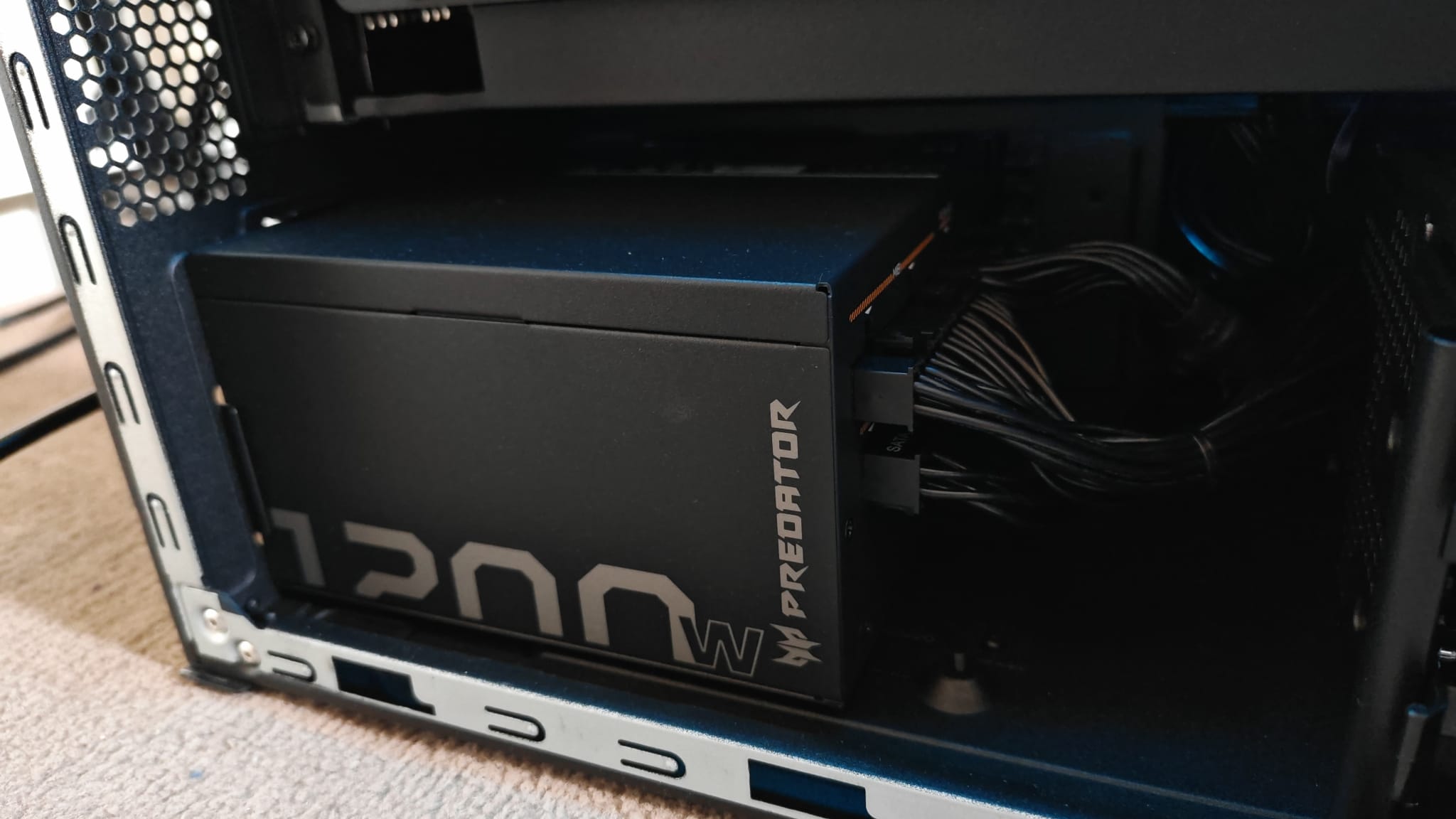
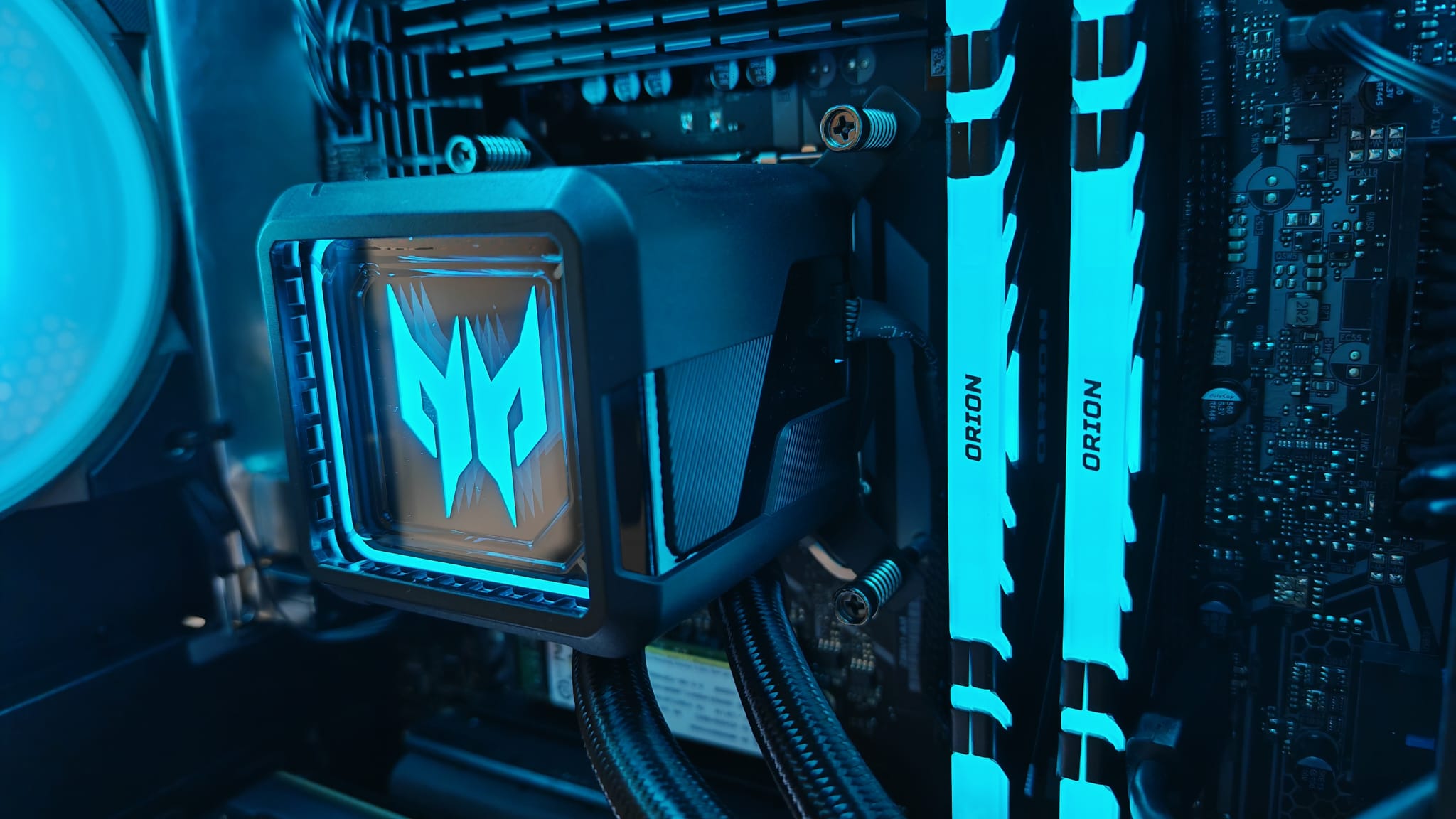
I'm very impressed with how the RAM performed in the AIDA64 Extreme benchmark, too. I've just received some of Acer's DDR5 RAM to test separately, and I'm now very excited to see what it can do. Annoyingly, I had to go into the BIOS myself and turn XMP on to get the best out of it, but hey, at least this is now an option in the Predator BIOS menu, which it wasn't last time.
Looking at gaming, there are a lot of scores to admire here. This shouldn't come as a shock since the RTX 5080 is really the 4K graphics card to beat for most gamers at the moment, and it does most of the heavy lifting for this PC.
Rather unsurprisingly, the RTX 5080 outperforms the CyberPowerPC we tested in 4K gaming benchmarks. For how much more the 5080 will set you back in dollars and cents than an RX 9070XT, the performance boost isn't massive.
Still, the results are very, very similar to the ones I saw when benchmarking the NZXT Player Three that also harnesses the RTX 5080, and if Acer has come away with any wins here, it's mainly tests that concern DLSS, and these performance increases could be due to many factors, including driver updates.
It's hard to distinguish a clear winner between the AMD Ryzen 7 9800X3D in NZXT's machine and the Intel CPU used here. Both perform really well when put alongside the 5080. AMD sneaks in a win in Total War: Warhammer 3's Battle benchmark, but not by much. That 3D V-cache definitely shows its worth when you look at the price of it, which is why I'd be really keen for Acer to use these next time around.
Overall, this is an excellent PC that performs brilliantly in 4K gaming tasks, as expected.
Should you buy the Acer Predator Orion 7000 (2025)?
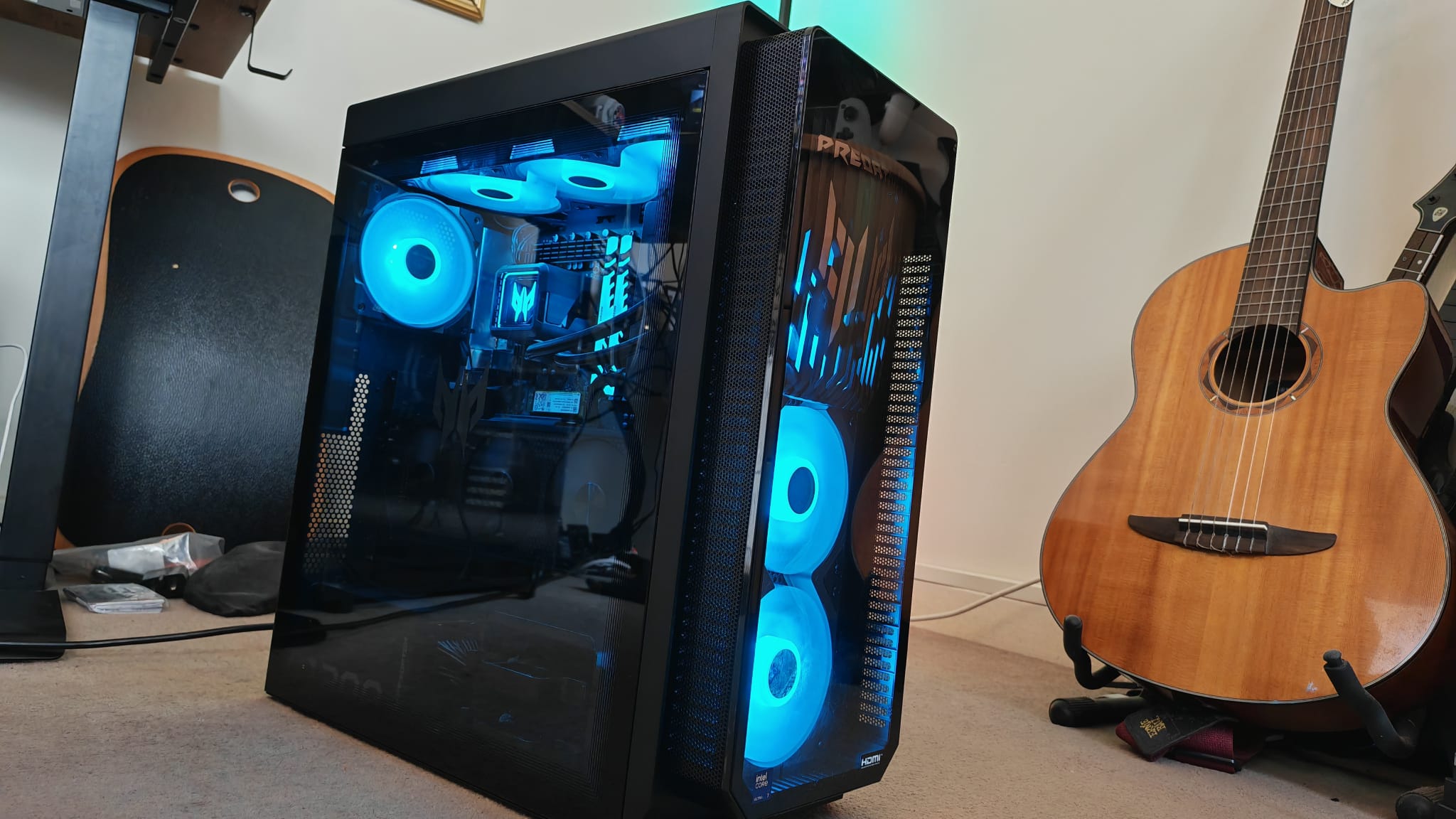
More than any iteration of the Predator Orion 7000 that's come out previously, you should absolutely buy this PC if you're on the hunt for a high-end configuration. It's a gaming powerhouse, and the innovations and improvements that have gone on behind the scenes have made massive strides to tackle the issues I had with its predecessor.
Frustratingly, I can't bring myself to give this thing a better review score than the last model, even with all the improvements. As great as it is, it's available at Currys in the UK for £3,299, and that's an inexplicably high price to pay - even for an RTX 5080 computer. It's harder to judge this PC in raw value because of how many proprietary parts are used. The PSU, the chassis, the cooler, the fans, and the motherboard aren't sold separately, so I can't put them into PCPartPicker and see how much it'd be to build them together yourself. But I can look at the price of other RTX 5080 gaming PCs and see that even if they're over £2,000, they're not quite £3,299. To be honest, most keep themselves under the £2,500 mark.
With other manufacturers charging ~£100/$100 for builders' fees on top of the value of the PC they're selling you, I'd understand if this one was just over £2,500. Acer is a big name, after all. As it stands, there has to be something funky going on for this to sit £300 over £3,000. With so many smaller brands offering as close to the value of parts as possible, it's tougher for me to recommend this PC to you because you can get similar specs for far less cash.
Thankfully, Predator Orion 5000 options will exist, and I do see them discounted on occasion. But if there's one thing I wish for the next iterations of Acer gaming PCs, it's a more reasonable price tag. These PCs are amazing, but I can imagine them being prohibitively expensive for most gamers. Perhaps this brand moving into the use of AMD value parts (including its own GPUs), could bring down the price next time.
How I tested the Acer Predator Orion 7000

I put the 2025 Orion 7000 through the same gaming PC benchmarking process that we force every prebuilt machine we review through. As well as using it for average day-to-day tasks, I performed a number of industry-standard benchmarking tests that are designed to make every component sweat, as well as ones that test the performance of the whole PC working together.
I also put it through the wringer of demanding games. This included Shadow of the Tomb Raider, Returnal, Black Myth Wukong, Cyberpunk 2077, and Total War Warhammer 3.
For more on how we test gaming PCs here at GamesRadar+, check out our hardware policy.
Want to get to know your PC parts a little better? Check out the best RAM for gaming, the best graphics cards, and the best SSDs for gaming.
One of my earliest memories is playing SuperMario64 and wondering why the controller I held had three grips, but I only had two hands. Ever since I've been in love with video games and their technology. After graduating from Edinburgh Napier University with a degree in Journalism, I contributed to the Scottish Games Network and completed an Editorial Internship at Expert Reviews. Over the last decade, I’ve been managing my own YouTube channel about my love of games too. These days, I'm one of the resident hardware nerds at GamesRadar+, and I take the lead on our coverage of gaming PCs, VR, controllers, gaming chairs, and content creation gear. Now, I better stop myself here before I get talking about my favourite games like HUNT: Showdown, Dishonored, and Towerfall Ascension.
You must confirm your public display name before commenting
Please logout and then login again, you will then be prompted to enter your display name.
